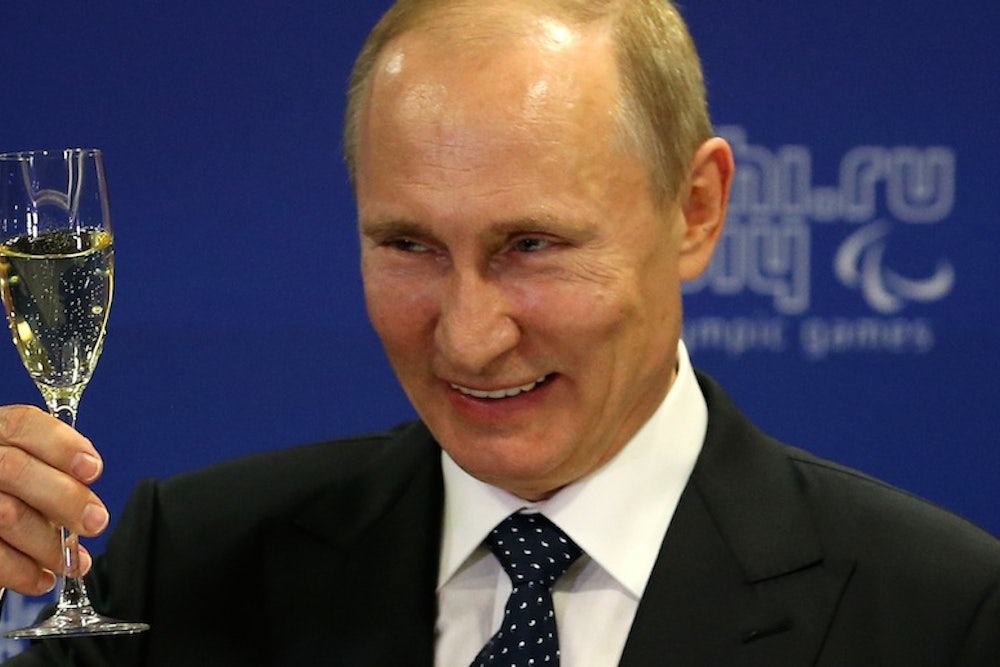The Department of Defense has been spending $300,000 per year to analyze the body language of world leaders including Russian President Vladimir Putin, Pentagon Press Secretary John Kirby revealed last week. “The researcher examines the body movements and body language of various world leaders to determine a better understanding of their decision-making process,” he said.
Is this a waste of taxpayer money, or can it really help us understand politicians' behavior? We asked body language researchers to analyze Putin’s movements at his press conference last week. This is what you get for $0.
Joseph Tecce, Boston College psychology professor
"He showed an unusual number of quick head movements and the lip licking, suggesting nervousness. And, as the interview progressed, he shifted his body posture from sitting straight to being somewhat tilted in an attempt to relax more, another indication that he was feeling tense. Later he showed gaze aversion, a clear sign of unpleasant feelings.
"The normal range of blink rate on camera is 30 to 50 blinks per minute (BPM). (If you’re sitting at a picnic table, it’s 15-20.) At 42 BPM, Putin’s rate was a bit high, considering the structured setting that guaranteed his complete control. Anytime you blink fast, it shows that you’re experiencing stress and unpleasantness."
Patrick Stewart, a political scientist who researches politicians’ nonverbal communication at the University of Arkansas
"The decision to give a press conference while sitting in a chair without barriers and at the same height level as the press corps appears to be similar to that of someone who signals his formidability when trying to start a fight by sticking his chin out: It is a subtle indicator that he has nothing to fear.
"Displacement activities—touching the head or face, fidgeting with an item such as a ring or a pen, combing the hands through the hair—tend to indicate a level of stress. Putin touches his nose when discussing the legality of removing the president under Ukrainian law and again when talking about the Paralympics. There were also head scratches."
Maria Grabe, a telecommunications professor at Indiana University and coauthor of Image Bite Politics: News and the Visual Framing of Elections
"He’s very powerful, non-verbally. His face is plastic enough that he can very subtly shift, and he uses a full emotional range.
"He has a tendency to screen up and left, avoiding eye contact with the journalists. This is what we would call an avoidance response. When he has to talk about violence and force, you see that screen left. The other thing he does that's an avoidance response is that he looks down. But most of the time he is in full engagement. He’s a very interactive communicator—he feeds off the journalists’ non-verbal responses to him
"The other places I can see that he reveals himself is in angry moments. He starts enunciating very clearly—that is anger. He over-enunciates and the lower teeth come out.

"He can go from anger to quite a bit of compassion, in that Clintonian kind of way—those 'I feel your pain' kind of non-verbals. His eyes will meet a journalist’s and he’ll lean forward."
Erik Bucy, who researches non-verbal communication at Texas Tech University
"At first his gaze is averted and downcast, as if he is searching for an answer. Nonverbal cues like that are equated with evasion, or avoidance. His pauses, filler utterances and head tilts suggest that he’s searching for a narrative.
"As time goes on, Putin ... shows much more aggression in his facial expressions, frequently baring his lower teeth—a clear anger/threat display—furrowing his brows, accelerating his rate of speech, and using an angry tone of voice."
